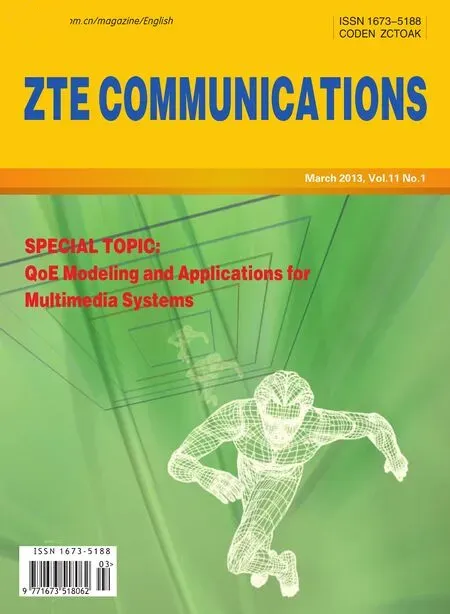Battery Voltage Discharge Rate Prediction and Video Content Adaptation in Mobile Deviceson 3G Access Networks
Is-Haka Mkwawa and Lingfen Sun
(School of Computing and Mathematics,University of Plymouth,Plymouth,PL4 8AA,UK)
Abstract According to Cisco,mobile multimedia services now account for more than half the total amount of Internet traffic.This trend is burdening mobile devices in terms of power consumption,and as a result,more effort is needed to devise a range of power-saving techniques.While most power-saving techniques are based on sleep scheduling of network interfaces,little has been done to devise multimedia content adaptation techniques.In this paper,we propose a multiple linear regression model that predicts the battery voltage discharge rate for several video send bit rates in a VoIP application.The battery voltage discharge rate needs to be accurately estimated in order to estimate battery life in critical VoIP contexts,such as emergency communication.In our proposed model,the range of video send bitrates is carefully chosen in order to maintain an acceptable VoIPquality of experience.From extensive profiling,the empirical resultsshow that the model effectively saves power and prolongs real-time VoIP sessions when deployed in power-driven adaptation schemes.
Keyw ords QoE;power;mobile devices;quality adaptation;discharge rate
1 Introduction
A ccording to the Cisco Visual Networking Index of the Global Mobile Data Traffic Forecast,mobile video traffic accounted for 52%of total Internet traffic at the end of 2011[1].Mobile video traffic will continue to increase so that by 2016,two-thirds of mobile data traffic will be video.YouTube and Facebook account for more than 30%of all Internet traffic,YouTube accounting for a bigger portion of this traffic than Facebook[1].Most video traffic goes to mobile devices;however,mobile applications use a considerable amount of power,especially when video is involved[2],[3].Processing power and storage capacity hasgrown exponentially over the past few years,but battery life has not.Power conservation in mobile devices has been extensively researched.Power-saving techniques,such as mobile resource management,power-aware operating systems,and Wi-Fi/3G sleep schedulinghavebeen exploited[4].
CPU,LCD,GPS,Wi-Fi,and 3Gcomponents consume a lot of power,as do multimedia applications.Any effort to reduce power consumption in any one of these components and applications is of paramount importance.In the case of video VoIP,GPScan be switched off because it is not needed,and one of the network interfaces can also be switched off depending on the access network being used.However,the LCD must not be switched off in order to allow the video watching.
Sleep scheduling techniques cannot be applied in this situation because the communication is in real time.Sleeping schedules conflict with highly delay-sensitive VoIP services and degrade VoIP(QoE)[5].Therefore,it is more appropriate to adapt multimedia VoIPapplications than network interfaces in order to save energy.This approach has led to a content-adaptation technique that can be used to save energy and maintain VoIPQoEat an acceptablelevel[6].
Thispaper describes an extension of the power-driven adaptation scheme proposed in[6].In this scheme,video send bitrates(SBRs)were mapped into battery charge levels.In the proposed scheme,battery life during VoIP communication was not predicted;hence,selection of SBRs did not determine the length of the VoIPsession.
In this paper,we use a multiple linear regression analysis to predict the battery voltage discharge rate.By predicting this rate,we can accurately estimate the battery life,and appropriate SBRs can be used to save power or prolong the VoIP session.The secondary purpose of this paper is to revise the power-driven VoIPadaptation scheme proposed in[6]sothat it includesthebattery voltagedischargeratefor SBRselection.
2 Related Work
The authors of[7]proposed a framework that reduces power consumption in Wi-Fi video streaming.The proposed framework uses various video SBRs to adjust sleep intervals of the Wi-Fi.This reduces power consumption and,at the same time,maintains video quality.In[8],the same technique was also proposed,and the Power Save Mode(PSM)standard was used[9].These frameworks do not address key issues in real-time VoIPcommunication,where the delay or loss of important signalling traffic,such as SIP,can affect the real-time communication.
The authors in[10]proposed a system context-aware approach to predict the life of a smartphone battery.They showed how changing mobile system components affects the life of a battery.A video player application with LCD brightness was used as a dependent variable;however,video content adaptation was not considered.This can also lead to another dependent variable,and more power can be saved.In this paper,we go beyond their approach and consider video content adaptation in termsof video SBRs.
In[6],we proposed a power-driven adaptation scheme in which SBRs are switched in order to save power over Wi-Fi networks.Wi-Fi power is consumed in either the listening state or transmission state.Power consumption levels in these two states were constant and could be broken down into low and high power levels.However,we did not predict the battery voltage discharge rate,which is useful for estimating the battery life for each proposed SBR duringthe VoIPsession.
Here,we propose a multiple linear regression model that can be used to predict the battery voltage discharge rate for several video SBRs.The proposed model is then used to estimate the battery life during a VoIPsession.The range of video SBRs is carefully chosen in order to maintain acceptable QoE.
3 Experimental Testbed
We developed a testbed based on Open IMSCore to evaluate the proposed model(Fig.1).Session Initiation Protocol(SIP)[11],the de facto signaling protocol in IMS,was used to establish and terminate a VoIPsession.
Two HTC Dream G1 mobile phones with Android 2.3 were ported with IMSDroid[12]and used asclientsfor VoIPcommunication.The Universal Mobile Telecommunications System(UMTS)access network wasprovided by O2 UK.For voice sessions,the AMR-NBbase profile codec was used,and for video sessions,the H264 base profile codec was used.An Android-based power monitoring tool called Powertutor[13]was installed on themobilephones,and statisticswerecollected every second.The power sources for both mobile phones were rechargeable1100 mAh,3.7 V lithium-ion batteries.
OpenSips[14]and OpenXCAP[15]were deployed in the testbed for presence capabilities and to store monitored battery charge and power levels in a centralized way.
4 Evaluation of Power Consumption
In this section,we evaluate the power consumption of mobile components that significantly contribute to overall power consumption in the system.Power consumption differs between mobiledevicesbecauseof softwareand hardware.
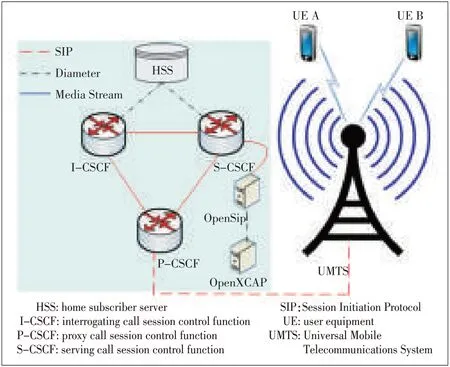
▲Figure1.Experimental testbed.
4.1 3G Interface
Fig.2 shows the power consumed by the 3G interface in the HTC Dream G1.The chipset is a Qualcomm RTR6285.According to 3GPP,3G has three states:IDLE,dedicated channel(DCH),and forward-access channel(FATCH).IDLE is the low-power-consumption state:the radio resource control is in IDLEwhen no data is being transmitted.DCH and FATCH are high-power-consumption states.DCH guarantees low delay and high throughput by reserving dedicated channels to mobile devices.The FATCH state occurs when there is less traffic,and thechannel isshared between mobiledevices.
Timers control the transitions between states.The transition fromlow-power tohigh-power state isimmediate,but the transition from high-power to low-power state occurs only when the network has been inactive for a certain period of time.The transitional power from low-power to high-power state iscalled ramp power,and the transitional power from high-power to low-power state is called tail power[16].The following stepsdescribehowpower isused by the3Ginterface(Fig.2):
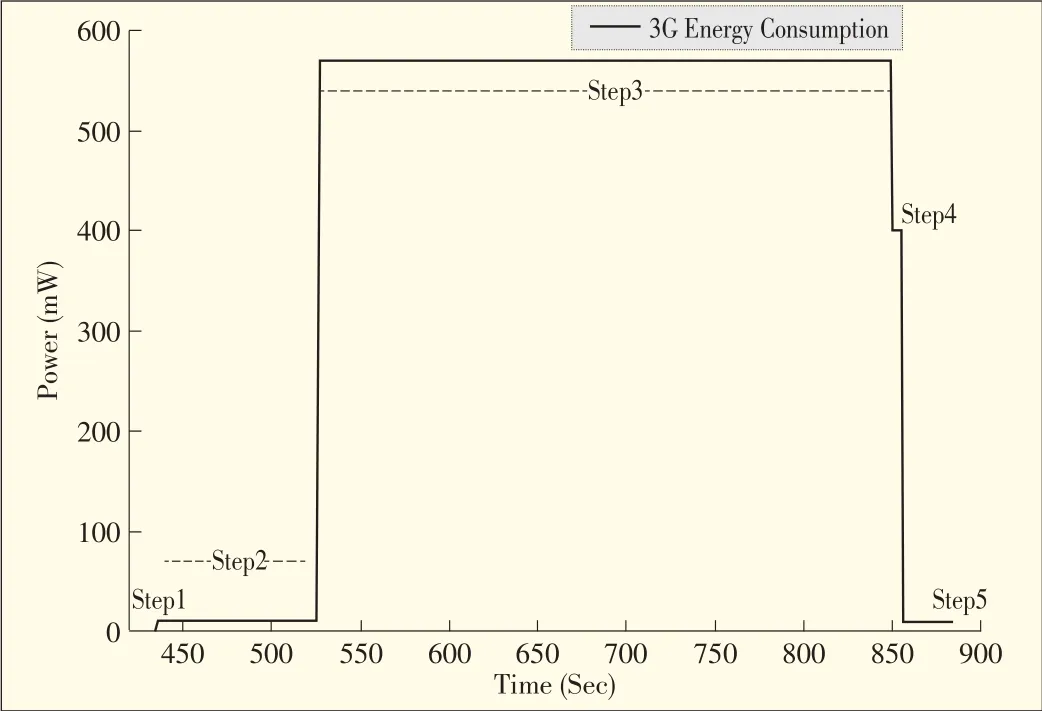
▲Figure2.Power consumed by the3Ginterface.
1)The 3Ginterface is off and nopower isconsumed.
2)The 3G interface is on,but no data is transmitted.An average of 10 mW is recorded,and the interface is in the low-power state.
3)VoIP multimedia transmission is started,and the interface is in a high-power state.An average of 570 mWof power is consumed.The power consumed during the transition from low-to high-power states is called ramp power.
4)VoIP multimedia transmission is stopped.The 3G interface waits for a fixed time before reverting to the low-power phase.An average of 401 mW of power is consumed,and the average wait time is six seconds.The power consumed during the transition from high-to low-power states is called tail power.
5)Low-power state.
The empirical results show that the high-power state of the 3Ginterfacedoesnot affect thetransmission rate(Fig.3).
4.2 VoIPApplication
Fig.4 shows the power consumed by the IMSDroid AV application during the VoIP communication,which can be described by thefollowingsteps:
1)IMSDroid isoff,and nopower isconsumed.
2)IMSDroid is switched on.The SIP and RTPstacks are initialized,and VoIPregistration occurs at the IMSserver.An average of 230 mWof power is consumed.
3)SIPsignaling traffic for session negotiation is communicated which is then followed by the establishment of the RTP voice media communication.An average of 160 mWof power isconsumed.
4)The incoming video transmission is initiated.An average of 370 mWof power is consumed.
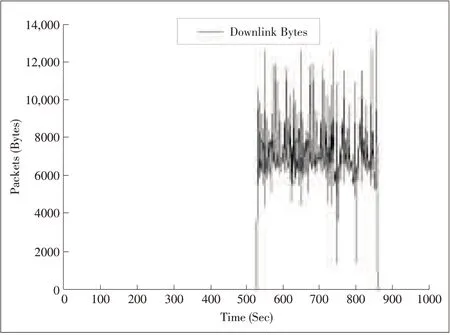
▲Figure3.Datatransmission ratewhen 3Ginterfaceisin a high-power state.
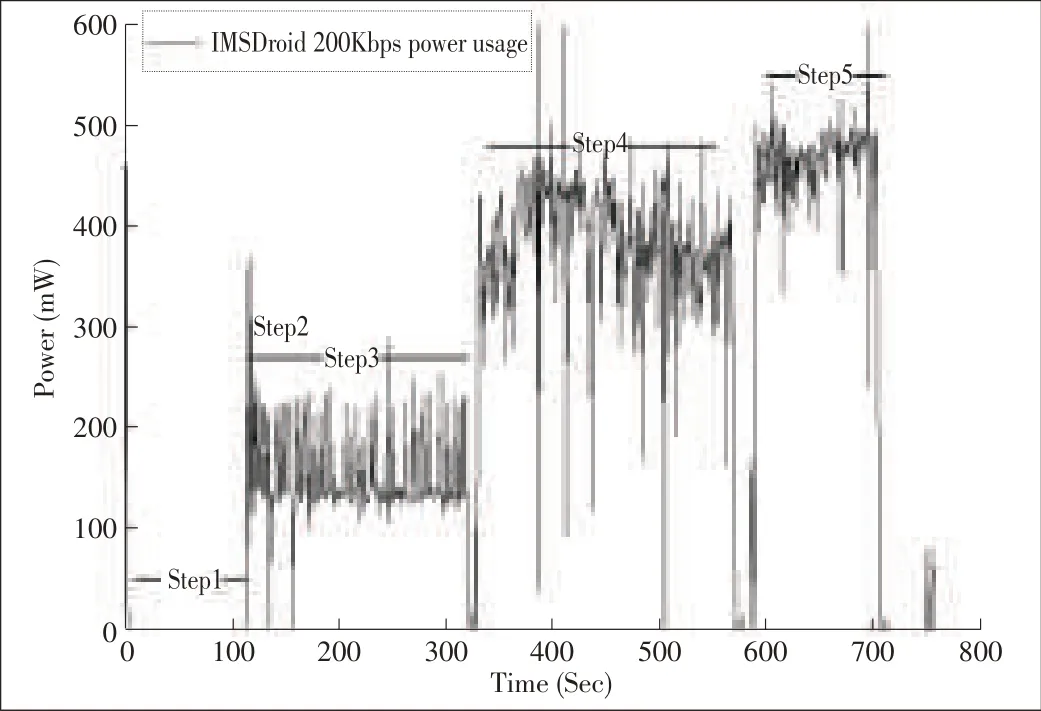
▲Figure4.Power consumed by IMSDroid.
5)The outgoing video is triggered,and power consumption increasestoan averageof 470 mW.
4.3 LCD
Fig.5 shows the power consumed by the glass TFT-LCD touch-sensitive HVGA screen.At an average of 360 mW,power consumption is the lowest when the brightness level lowest(i.e.when the brightness level is 30).At an average of 900 mW,power consumption isthehighest when thebrightnesslevel is highest(i.e.when the brightness level is 255).Lowering the brightness significantly saves power,but the brightness level must be carefully selected so that it does not degrade the VoIP QoE.We set the brightness level at 30,127 and 255 in theproposed multiple-regression model.
4.4 CPU
Fig.6 shows the power consumed by the MSM7201A chipset,which includes an ARM11 application processor,ARM9 modem,and high-performance DSP.At an average of 45 mW,power consumption is lowest when the VoIPapplication is not running.At an average of 335 mW,power consumption is highest when the VoIPapplication isrunningat 50 Kbps.
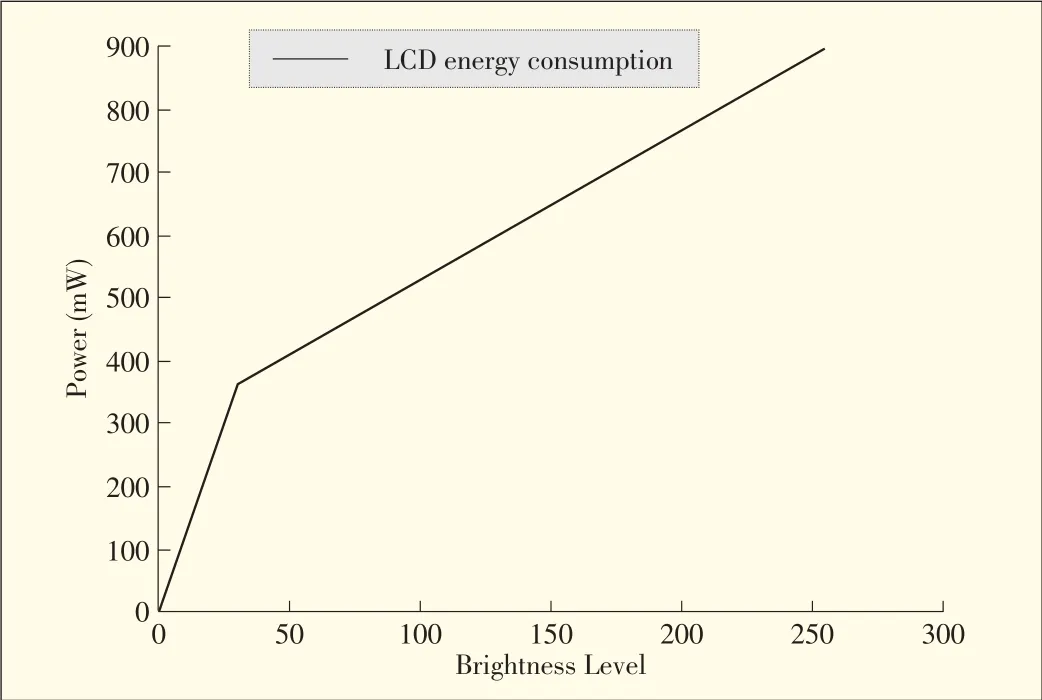
▲Figure5.LCDpower consumption.
4.5 Total Power Consumption
Fig.7 shows the total power consumed by the mobile phone during the video VoIPsession,which can be described by the followingsteps:
1)The3Ginterfaceisoff.
2)The3Ginterfaceison and in listeningmode.
3)The VoIPapplication is started.
4)The VoIPapplication is registered to the IMS.
5)The VoIPsession isestablished.
6)RTPaudiotraffic flows.
7)Theincomingvideoisplayed.
8)Theoutgoingvideoistransmitted.
5 Battery Voltage Discharge Rate Prediction Model
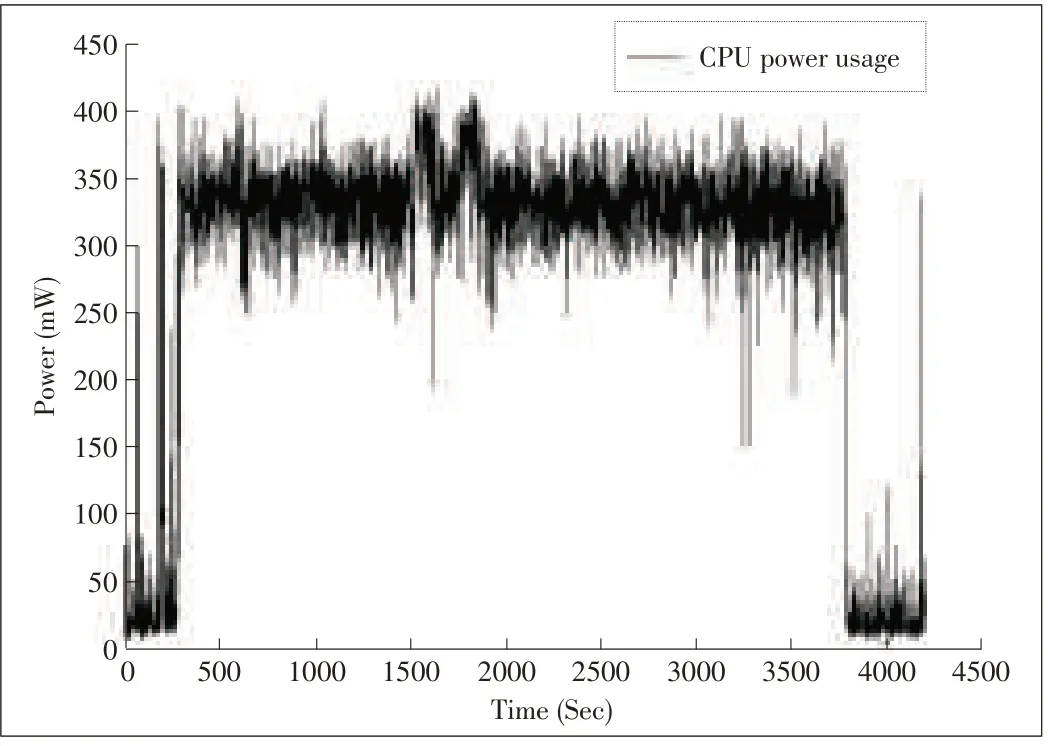
▲Figure6.CPUpower consumption.
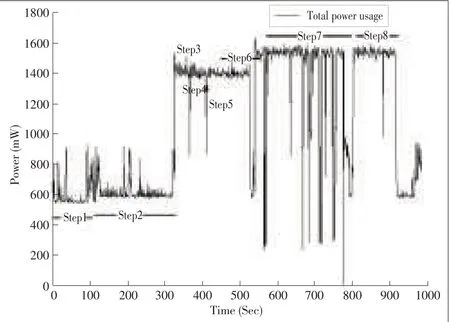
▲Figure7.Total power consumed by themobilephoneduringthevideo VoIPsession.
The battery life can be estimated by predicting the battery voltagedischargerateduringa VoIPsession.It isgiven as

whereβis the battery voltage discharge,and viand vj(for vi>vj)arethebattery voltagesat time i and j.
Fig.8 shows the battery voltage discharge rate for different SBRs during the VoIPsession.In the steady state,power consumption and,consequently,battery voltage discharge increases as the video SBR increases[6].An appropriate video SBR can be chosen to save power and/or prolong VoIPcommunication without compromising the video QoE.The range of H264 codec SBRs for which there is an acceptable QoE has been tabled in[17].These SBRsweredeployed in[6].
Through extensive profiling,we found that during the VoIP session,there is a linear relationship between battery voltage discharge(a dependent variable)and independent variables such as CPU,LCD,GPS,Wi-Fi,and 3Ginterfaces.The video SBRs can therefore be varied and multiple linear regression analysis used to predict the battery voltage discharge.The battery voltage discharge rate is the dependent variable,and the main power-consuming components(i.e.CPU,LCD,GPS,Wi-Fi,3G and IMSDroid)are independent variables.During the VoIPsession,the CPU,GPS,Wi-Fi and 3Gare kept constant.The 3Gand Wi-Fi interfacesareeither on or off,and only one interface is used at a time during the VoIP session.In this paper,a 3Ginterface is used and is switched on,from the start to the end of the session.The brightness level of the LCD backlight in the HTC phones is allowed to vary between 30 and 255,which improves the quality of the video session.The GPSinterface is not needed in this scenario and is therefore switched off.Table 1 lists independent variables and their rangeof valuesconsidered in thispaper.
Table 2 shows the sample data for the battery voltage discharge,LCD,and VoIP application.The CPU frequency remained constant at 245 MHz during the course of the experiment.The 3Ginterface was switched on from the beginning to the end of the VoIPsession and did not vary in its power consumption.The GPSinterface was off and did not affect power consumption in theexperiment.
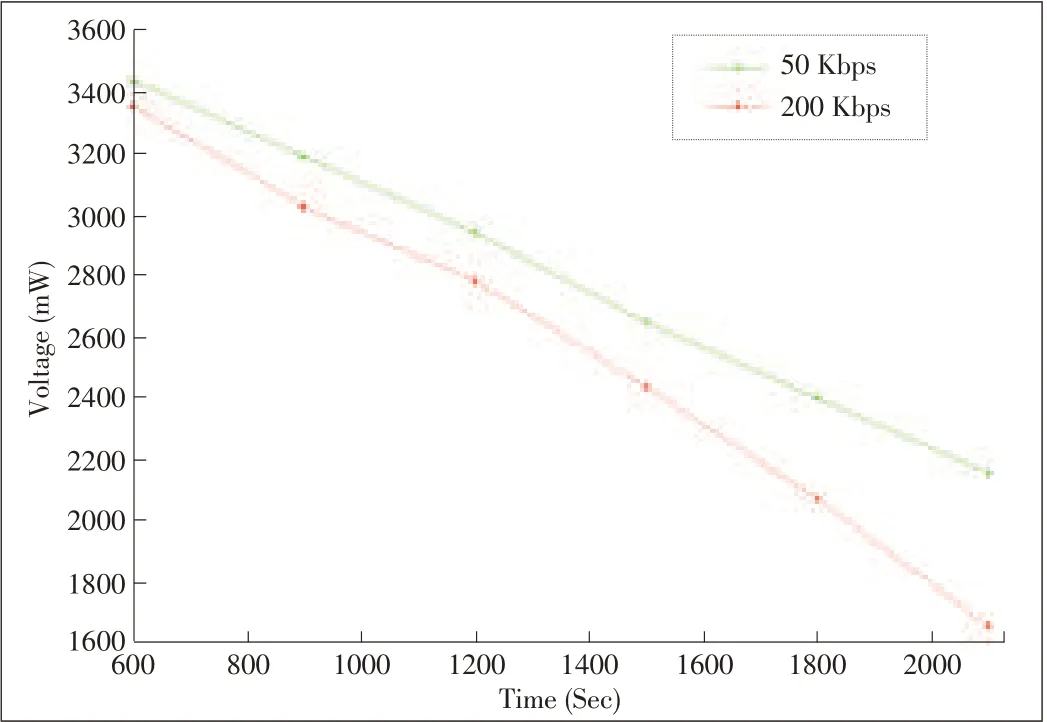
▲Figure8.Battery voltagedischargeratefor different SBRsduringthe VoIPsession.
Therefore,the remaining independent variables were the LCDand VoIPapplication viaitsvideo SBRs.
Theregression model isthen expressed as

▼Table1.Independent variables

▼Table2.Sample Data

where V isthebattery voltage,X1,...,Xkare independent variables(Table 2),andαandβ1,...,βkare the regression coefficients to be estimated.The independent random error is given byε.In regression analysis,αandβ1,...,βkare estimated by assumingεis normally distributed;that is,the meanμ=0 and standard deviationδ=1.
The method of least squares is used to calculate the coefficients of(2)in order to yield the best-fitting equation.In this paper,k=2,X1=VoIP,and X2=LCD;therefore(2)becomes

If only VoIP is considered and the rest of the independent variablesarekept constant,(3)can bereduced to

whereβ1is the slope of the regression line that represents the battery voltage discharge rate contributed by the VoIPapplication,andαis the line intercept,which represents the voltage when the VoIPapplication is off.When the VoIPapplication is on,αis the combined voltage contributed by other independent variables.
6 Experimental Results and Evaluation
Experimental results in[6]showed that 10-30%power was saved when SBRs were changed from 200 Kbps to 50 Kbps(Fig.9).In this paper,the results[6]are extended and used to predict the battery voltage discharge in order to estimate the battery life.The estimated battery life is used as one of the inputsintotheproposed power-driven adaptation scheme[6].
Fig.10 shows the battery voltage discharge rate when the video VoIPsession is operating at 50 Kbps.Fig.11 shows the battery voltage discharge rate when the video VoIP session is operating at 200 Kbps.When the video VoIP application is running at 50 Kbps,the battery voltage discharge rate is 0.8635 mV/s.When the same video VoIP application is running at 200 Kbps,the battery voltage discharge rate is 1.104 mV/s.When the video VoIPapplication is running at 50 Kbps,the voltage drops to 2400 mV around 1800 s after the battery is fully charged.When the video VoIP application is running at 200 Kbps,the voltage drops to 2400 mV approximately 1500 safter thebattery isfully charged.
With extensive profiling,we found that the CPU frequency was constant at 245 MHz during the VoIP session.When the 3G interface was always on,CPU frequency was constant.When the GPS was switched off,the remaining independent variables were LCD and VoIP.The multiple regression coefficients are estimated by using the least square method,and the followingequation isderived:
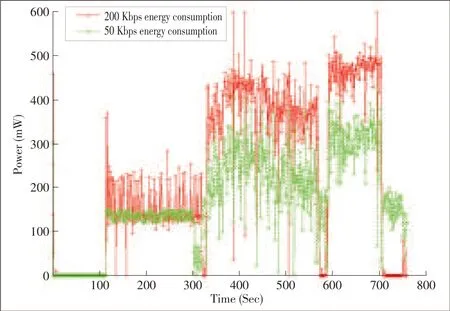
▲Figure9.Power savingastheresult of switching SBRs.

▲Figure10.Battery voltagedischargerateat 50Kbps.
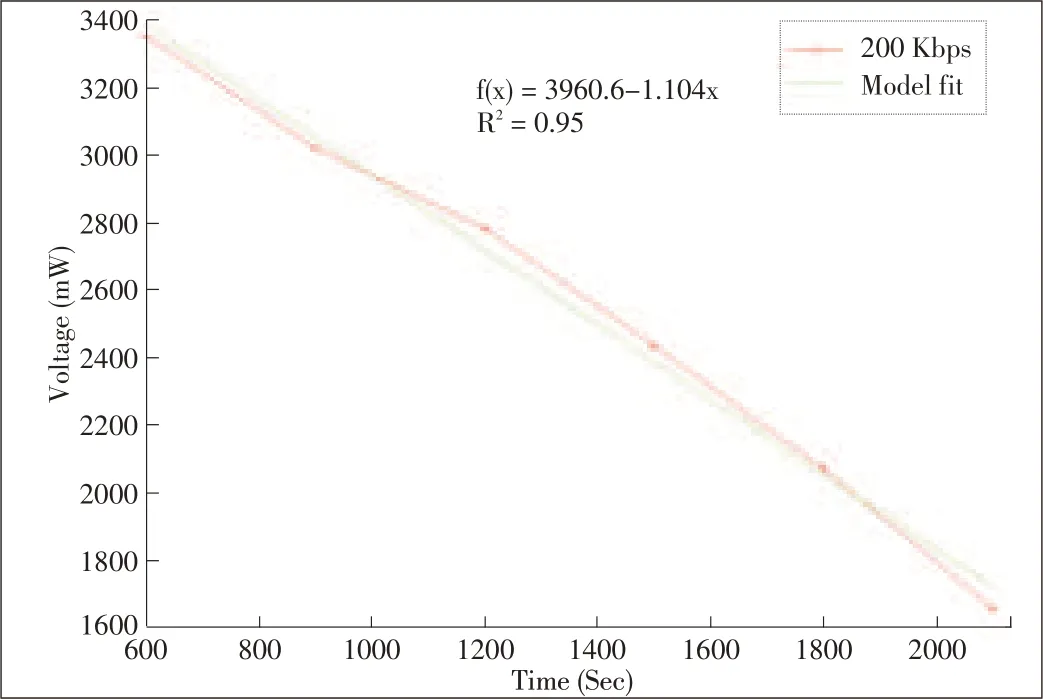
▲Figure11.Battery voltagedischargerateat 200Kbps.

From(5),the intercept has not significantly changed(Figs.10 and 11).This behavior is expected because if the LCDbacklight is switched off and the VoIP application is not running,the intercept is the expected maximum value when both LCD and VoIP application are switched off.The VoIP coefficient,which isthe battery voltagedischarge ratedueto VoIPapplication,changes very little,and this means that power consumption of the VoIP application and LCD backlight is not related.The battery voltage discharge caused by the LCD backlight was 1.563 mV,and the battery voltage discharge caused by the VoIPapplication was0.721 mV.
Theproposed model isevaluated usingthemean residual error and mean prediction error.The mean residual error was 0.7%,and the mean prediction error was2.21%.
7 Power-Driven VoIPAdaptation Scheme
In[6],a simple nonlinear regression analysiswas doneto estimate power consumption in the SBR range 50-500 Kbps(Fig.12):

where SBR(50 Kbps≤SBR≤500 Kbps)is the video send bit ratesof the H264 codec.
The battery charge levels(BCL)were mapped to the corresponding SBR values for VoIP quality adaptation.This mapping was then used in the power-driven adaptation scheme(Table 3,Fig.12).
The BCL was not associated with the battery life;therefore,it was not possible to estimate how long it would take to stay in each BCL.The proposed battery voltage discharge rate model allows us to accurately estimate the battery life in each BCL.For example,when the VoIP application is running at 50 Kbps,the battery power drops to 2400 mV 1800 s after the battery isfully charged(Fig.10).Thepower-driven VoIPadaptation scheme in[6]is revised to include the battery voltage dischargeratemodel(Algorithm1):
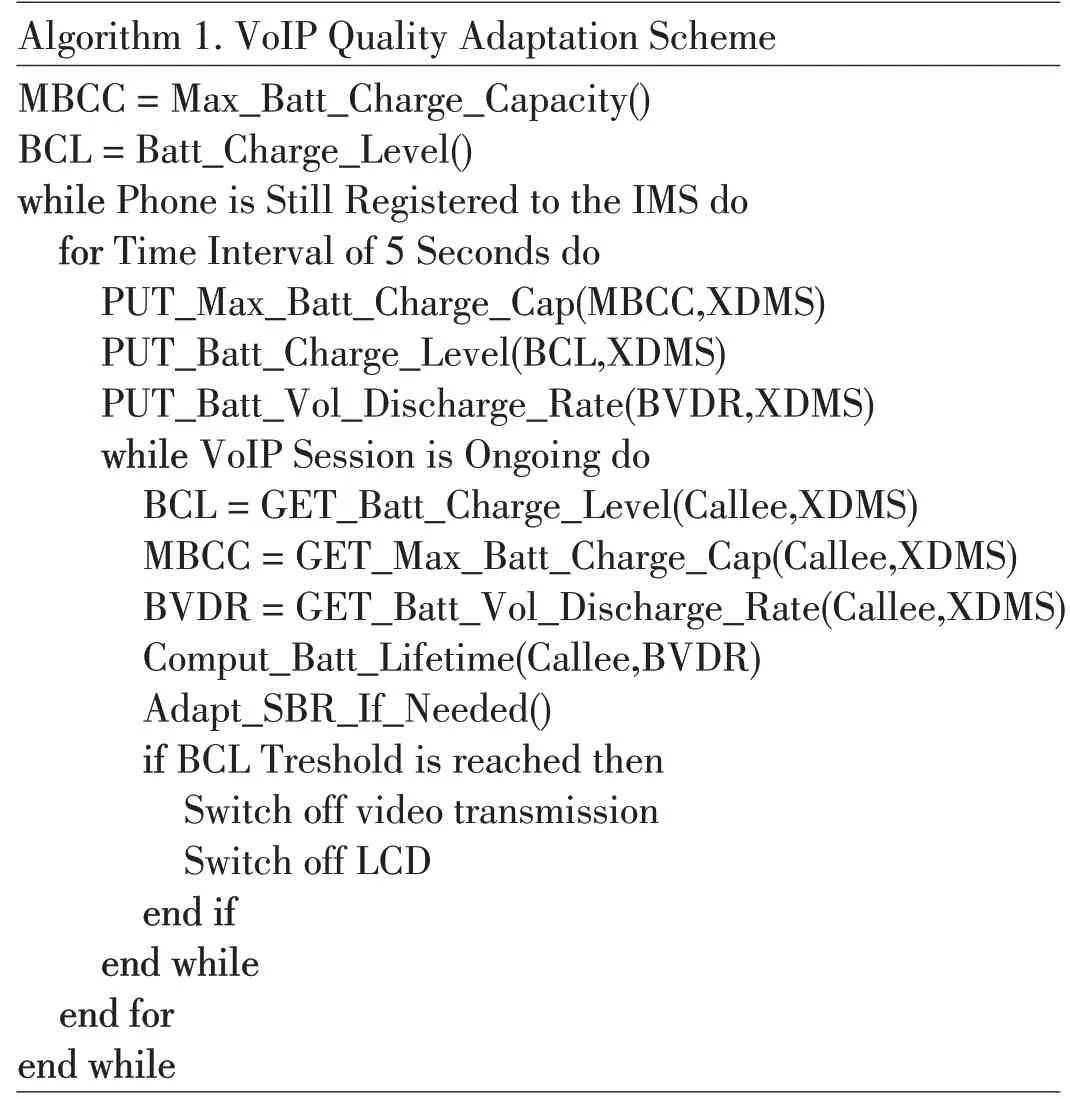
Algorithm1.VoIPQuality Adaptation Scheme MBCC=Max_Batt_Charge_Capacity()BCL=Batt_Charge_Level()while Phoneis Still Registered tothe IMSdo for Time Interval of 5 Seconds do PUT_Max_Batt_Charge_Cap(MBCC,XDMS)PUT_Batt_Charge_Level(BCL,XDMS)PUT_Batt_Vol_Discharge_Rate(BVDR,XDMS)while VoIPSession is Ongoingdo BCL=GET_Batt_Charge_Level(Callee,XDMS)MBCC=GET_Max_Batt_Charge_Cap(Callee,XDMS)BVDR=GET_Batt_Vol_Discharge_Rate(Callee,XDMS)Comput_Batt_Lifetime(Callee,BVDR)Adapt_SBR_If_Needed()if BCLTreshold isreached then Switch off videotransmission Switch off LCD end if end while end for end while
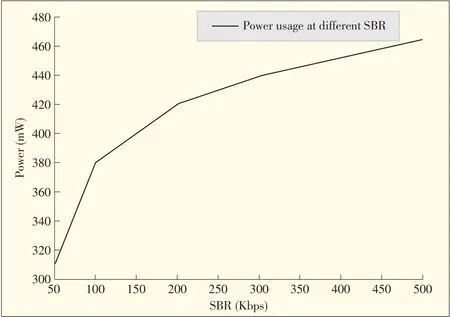
▲Figure12.Power consumption for different SBRs.

▼Table3.Mapping of BCL to SBR
1)The mobile phone uploads its maximum battery capacity,current battery charge level,and battery voltage discharge rate to the XDM server at the time of registration and then at five second intervals provided the mobile phone is still registered.Five seconds is specified in the RTCPcommunication standard.
2)The mobile phone uses the presence server and XDM server to retrieve power capabilities when initiating a VoIP session.
3)When initiating the VoIPsession,the mobile phone chooses thevideo SBRfor acceptable QoEand battery life.
4)The mobile phone monitors power capabilities and the battery life through the published data in the XDM server at five second intervals.
5)Using the battery charge level,the mobile phone computes the battery voltage discharge rate and calculates the battery life.
6)The remaining battery life determines how SBRs should be adapted while maintaining acceptable QoE.
7)If the battery is low,the video and LCDare switched off.Only voice communication is left running.In this paper,low battery chargeis1600 mV.
8 Conclusion and Future Work
In this paper,we have proposed a model for predicting battery voltage discharge rate in mobile devices on 3G networks.The model is based on a multiple linear regression analysis.We use a video VoIPapplication,in which different video send bit rates and LCD backlight levels are independent variables,and battery voltageisadependent variable.Theproposed model can be used to accurately estimate battery life in real time during critical VoIP communications,such as emergencies.The battery voltage discharge rate model has been used in the proposed power-driven adaptation scheme[6],and it was found that 10-30%of the total power could besaved when videosend bit rateswerechanged.
The proposed model can be extended to include several other video codecs,mobile devices,and VoIPapplications.
- ZTE Communications的其它文章
- ZTEConverged FDD/TDDSolution Wins GTIInnovation Award
- Introduction to ZTECommunications
- Android Apps:Static Analysis Based on Permission Classification
- Data Center Network Architecture
- FBAR-Based Radio Frequency Bandpass Filter for 3GTD-SCDMA
- An Improved Color Cast Detection Method Based on an AB-Chromaticity Histogram

